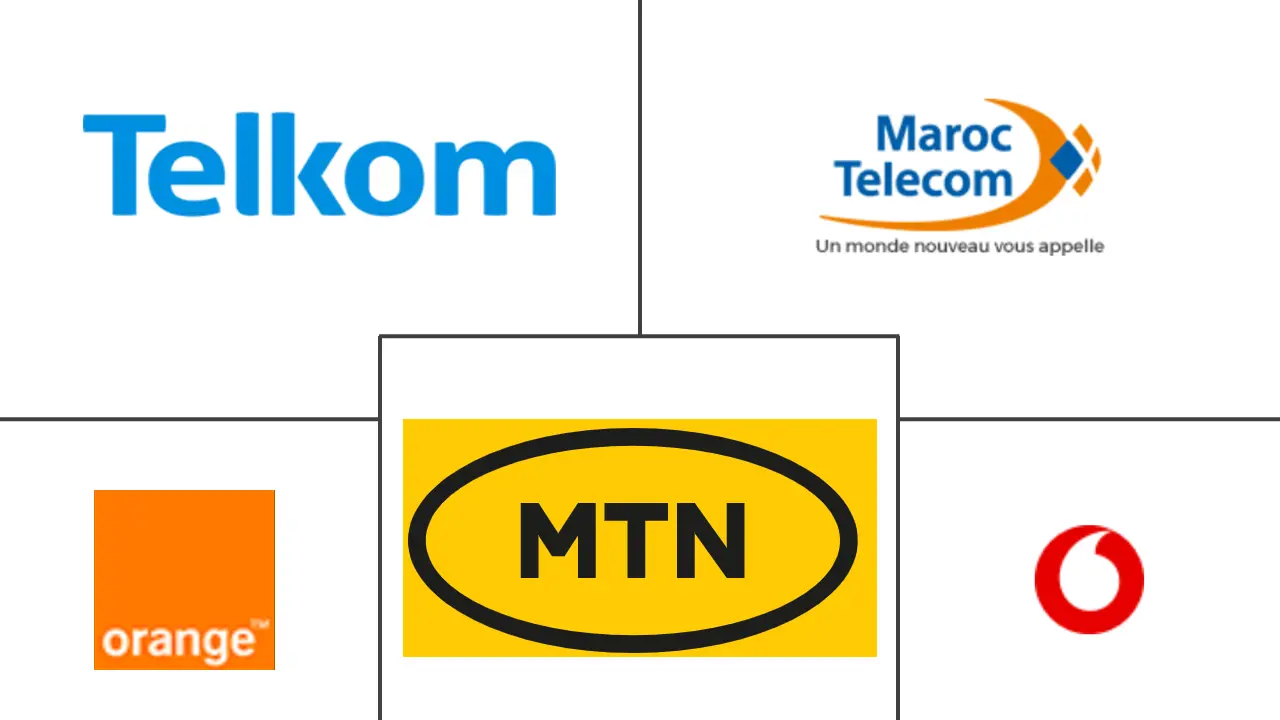Africa Entertainment And Telecommunication Market Size and Share
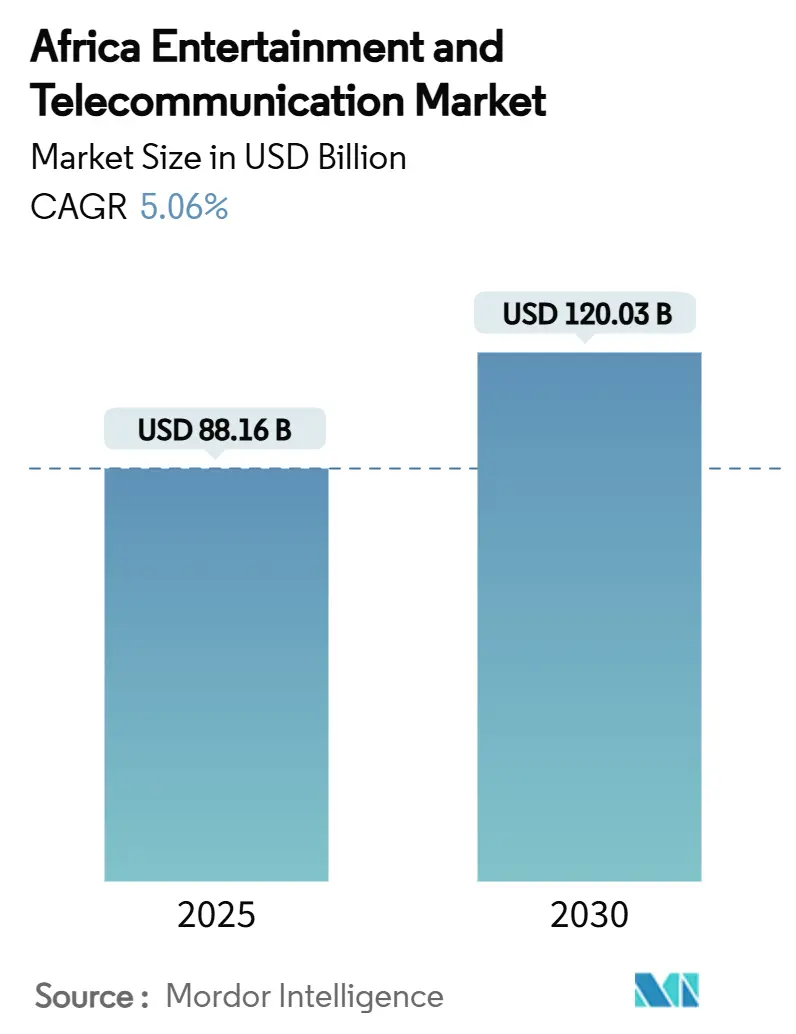
Africa Entertainment And Telecommunication Market Analysis by Mordor Intelligence
The Africa entertainment and telecommunication market size is estimated at USD 88.16 billion in 2024 and is forecast to expand to USD 120.03 billion by 2030, reflecting a steady 5.06% CAGR that underscores the region’s rapid digital shift.[2]GSMA Policy Team, “Infrastructure Sharing,” GSMA, gsma.com Growth rests on a widening 5G footprint, mobile-money-enabled data consumption, and rising appetite for on-demand video, music, and gaming. A dominant 76.1% revenue share in 2024 came from telecommunications services, whose reach positions operators to bundle content, payments, and cloud services into unified offers. Infrastructure-sharing mandates reduce tower capital expense, while coastal hyperscale data centers shorten content-delivery paths and open the door for cloud gaming. South Africa retained leadership with 29.6% share because of broad 5G coverage and supportive regulation, whereas Nigeria’s scale and 6.63% CAGR potential point to outsized upside despite currency headwinds. Advertiser-funded entertainment tiers, rising OTT local-content quotas, and satellite broadband expansion further underpin secular demand even as under-sea cable fragility, spectrum fees, and piracy temper momentum.
Key Report Takeaways
- By service type, telecommunications services led with 76.1% revenue share in 2024 while also recording the fastest 5.08% CAGR through 2030, confirming their centrality to the Africa entertainment and telecommunication market.
- By connectivity technology, 4G/LTE held 52% of Africa entertainment and telecommunication market share in 2024; 5G is poised to surge at a 32.7% CAGR during 2025-2030.
- By revenue model, subscription services commanded 68% share in 2024, whereas advertising-funded offerings are projected to grow at 7.8% CAGR to 2030.
- By subscriber category, consumers accounted for 85% of the Africa entertainment and telecommunication market size in 2024, while the large-enterprise segment is advancing at 6.63% CAGR through 2030
- By geography, South Africa led with 29.6% share in 2024; Nigeria is the fastest-growing national market at a 6.63% CAGR to 2030.
Africa Entertainment And Telecommunication Market Trends and Insights
Drivers Impact Analysis
| Driver | (~) % Impact on CAGR Forecast | Geographic Relevance | Impact Timeline |
|---|---|---|---|
| Rapid adoption of 5G and fiber broadband | +2.10% | GCC core, spill-over to Turkey | Short term (≤ 2 years) |
| Rising government esports investments | +1.80% | Saudi Arabia, UAE | Medium term (2-4 years) |
| Increase in Arabic-localized AAA and indie content | +1.50% | Middle East region | Medium term (2-4 years) |
| Proliferation of digital wallets and carrier billing | +1.30% | GCC, Turkey, Iran | Short term (≤ 2 years) |
| High smartphone penetration, falling data prices | +1.20% | Iran, Turkey | Short term (≤ 2 years) |
| Telco-tech cloud-gaming alliances | +0.90% | GCC core | Long term (≥ 4 years) |
| Source: Mordor Intelligence | |||
Mobile-Money-Bundled Data Plans Among Unbanked Youth
Operators merge financial inclusion with data uptake by integrating mobile-money wallets into data plans, removing banking friction for 60% of the continent’s youth. Airtel’s virtual card roll-out with Mastercard covers 14 countries and 150 million users, illustrating how micro-payments grow data consumption and streamline subscription fees for streaming and gaming. M-Pesa’s USD 267 billion annual throughput in Kenya underscores the scale at stake and signals a path to monetize content among price-sensitive consumers who previously relied on free messaging platforms.
Infrastructure-Sharing Mandates Lowering Tower CAPEX
Regulators in Nigeria and Uganda enforced tower and RAN sharing, enabling MTN and Airtel to slash overlapping build costs and accelerate rural 4G and 5G rollout. Passive sharing alone trims network cost by up to 50%, while active sharing adds a further 15-25% saving, freeing capital for service innovation and improving streaming quality by densifying coverage.[3]TechPoint Africa newsroom, “MTN Launches West Africa’s Largest Tier III Data Centre,” TechPoint Africa, techpoint.africa Tariff adjustments approved in 2025 help operators absorb rising energy and import expenses without diverting funds from coverage goals.
Local-Content Incentives Boosting OTT Subscriptions
South Africa’s draft 30% local-content rule for global streamers pushes platforms to increase African productions, echoing Nigeria’s content-localization guidelines. MultiChoice already scaled local output to 6,500 hours in 2024, lifting engagement and lowering churn as viewers favor regionally relevant stories. Investment flows to studios and post-production hubs, widening employment while enriching platform libraries.
Rapid Rollout of 5G Fixed-Wireless Access in Capital Cities
African operators pivot to 5G fixed-wireless access as a cost-efficient bridge where fiber coverage is thin. MTN reached 44% population coverage in South Africa by 2024 and switched on services in Benin and Republic of Congo within the same year, shrinking deployment timelines to under 12 months and delivering speeds above 100 Mbps that unlock cloud gaming and ultra-HD streaming. Spectrum pricing remains a brake in several Francophone markets, but pilot launches prove the model’s economic viability and support premium ARPU uplift in dense urban zones.
Restraints Impact Analysis
| Restraint | (~) % Impact on CAGR Forecast | Geographic Relevance | Impact Timeline |
|---|---|---|---|
| Fragmented regulations on loot boxes and in-game gambling | -1.40% | GCC, Turkey | Medium term (2-4 years) |
| High console hardware import duties | -1.10% | Turkey, Iran | Short term (≤ 2 years) |
| Energy-subsidy reforms lifting data-center opex | -0.80% | GCC core | Long term (≥ 4 years) |
| Economic-sanctions impact on payment processing | -0.60% | Iran | Medium term (2-4 years) |
| Source: Mordor Intelligence | |||
Under-Sea Cable Fragility Causing Backbone Outages
A March 2024 multiple-cable cut left West Africa facing five weeks of degraded connectivity, demonstrating how 95% of Africa’s international traffic depends on fewer than 5% of global submarine routes. A 2025 break in the Red Sea’s PEACE system produced similar disruption across East Africa. Streaming and cloud services suffered usage dips as rerouting raised latency and choked bandwidth. Extra landing points and the upcoming 2Africa cable promise relief, yet full redundancy remains years away.
Currency Devaluation Compressing ARPU in Key Markets
The naira’s 70% slide since 2023 pushed MTN Nigeria’s local-currency revenues higher but translated into a forecast 90% USD profit drop, highlighting the disconnect between nominal growth and hard-currency earning power . Airtel Africa’s 92% year-over-year profit decline reflects similar exposure. Currency hedges and locally sourced equipment offer partial buffers, but volatility limits capex funds and delays entertainment-oriented network upgrades.
Segment Analysis
By Service Type: Telecommunications Anchor Digital Platforms
Telecommunications services generated 76.1% of Africa entertainment and telecommunication market revenue in 2024 as reliable connectivity remained the prerequisite for digital content adoption. The segment’s 5.08% CAGR to 2030 stems from continued 4G densification, 5G expansion, and satellite broadband that bridges rural gaps. Voice still matters where smartphones are scarce, though data traffic now eclipses voice minutes in urban corridors. Investment focus shifts toward fiber backhaul and edge nodes that enable OTT streaming and mobile gaming without buffering, strengthening the ecosystem. Entertainment segments including video-on-demand, music streaming, and mobile gaming show faster percentage growth from smaller bases, supported by local-content measures that improve relevance and payment models that allow micro-subscriptions. Cross-selling between connectivity and content raises stickiness and underpins ARPU even as price sensitivity persists. Operators’ fintech arms broaden billing options, lowering churn by embedding media purchases within wallets.
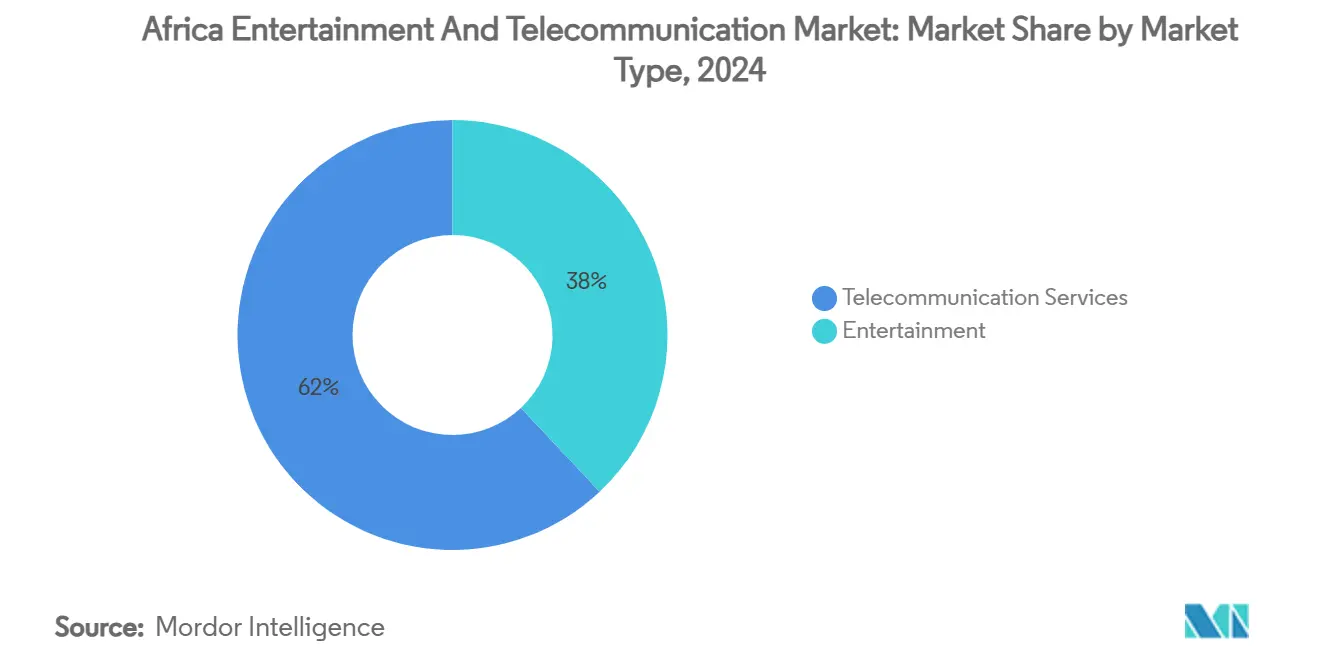
By Connectivity Technology: 4G Maturity Meets 5G Surge
4G/LTE retained 52% of Africa entertainment and telecommunication market share in 2024, but 5G’s 32.7% CAGR signals a decisive pivot. Densely populated metros adopt 5G first, where higher spectrum efficiency supports premium video and real-time gaming. MTN’s 5G-Advanced lab with Huawei attained 10 Gbps in tests, pointing to future enterprise and media applications that depend on ultralow latency. Operators in Francophone markets lag owing to elevated spectrum costs and regulatory layers, yet pilot programs are underway. Satellite broadband supplements terrestrial rollouts, bringing high-speed links to remote mines, farms, and schools. As 3G sunsets, refarmed spectrum bolsters 4G, ensuring backward compatibility for mid-range devices while freeing capacity for next-gen services.
By Revenue Stream: Subscriptions Remain Core While Ads Accelerate
Subscription models supplied 68% of 2024 revenue, testifying to consumer preference for predictable spend across data bundles, SVOD, and cloud storage. Africa entertainment and telecommunication market size linked to subscription flows is projected to keep expanding, though its relative share slips as ad-supported tiers grow at 7.8% CAGR. Streamers such as Showmax adopted hybrid monetization that pairs premium packages with free, ad-backed options, widening reach in cost-conscious segments. Telco-fintech integration permits pay-per-view and minute-based video plans whose micro-fees are auto-deducted from wallets, creating new avenues to monetize casual users. Licensing and wholesale channels rise in importance as content owners seek regional distribution partners that can bill in local currency and comply with quota rules.
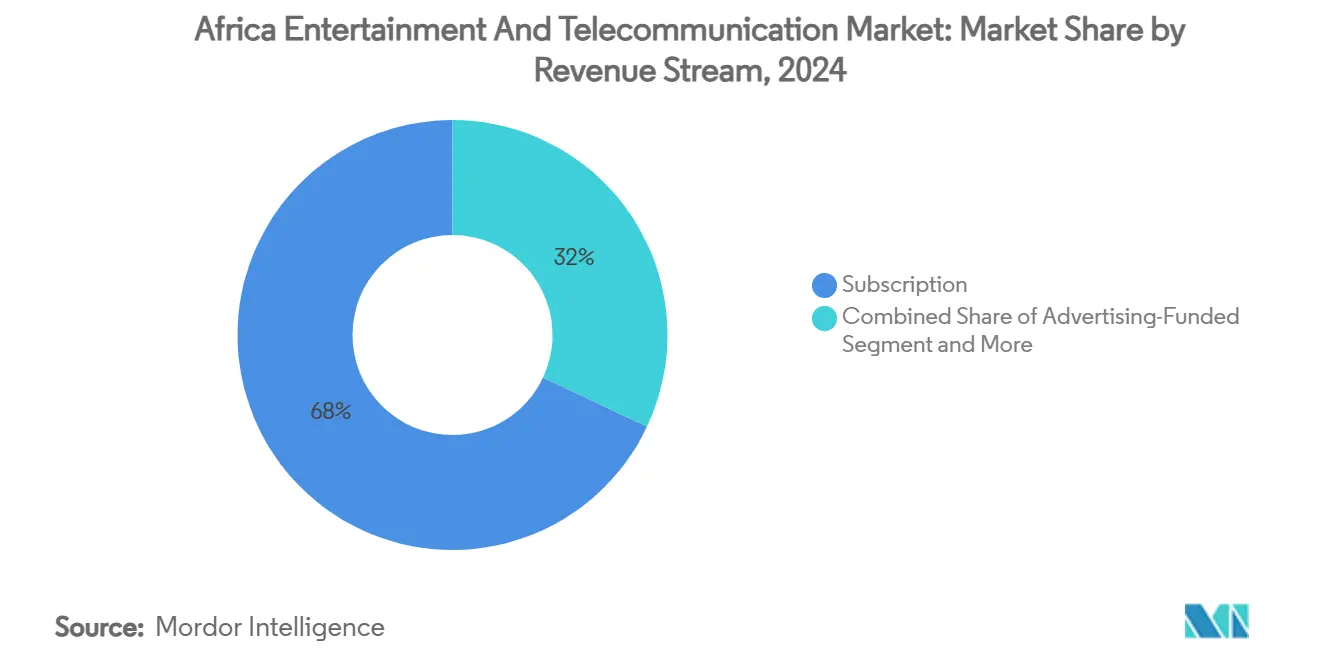
Note: Segment shares of all individual segments available upon report purchase
By Subscriber Category: Consumers Dominate but Enterprise Outpaces
Consumers accounted for 85% of Africa entertainment and telecommunication market size in 2024 as affordable smartphones and social media drove mobile data uptake. Average monthly data usage climbed sharply in South Africa and Nigeria once operators introduced mid-price 4G handsets. Enterprises, although smaller in volume, are on track for 6.63% CAGR as cloud adoption, remote work, and cybersecurity needs intensify. Wholesale fiber, private 5G, and unified communications packages align with corporates’ demand for reliability and low latency. Small businesses gradually digitize, using mobile POS and cloud accounting tools that ride on improved networks. Converged service bundles targeting both employee connectivity and customer engagement create upsell potential and diversify operator revenue beyond the saturated consumer market.
Geography Analysis
South Africa’s 29.6% share in 2024 stems from extensive fiber backhaul, 50%+ 5G population coverage, and a regulatory regime that supports infrastructure investment while enforcing local-content rules that stimulate production. Operators leverage this base to pilot 5G-Advanced and offer bundled cloud gaming. Currency swings and ownership caps complicate foreign investment, evidenced by Canal+ restructuring its MultiChoice stake, but high ARPU offsets such hurdles.
Nigeria offers the highest growth runway at 6.63% CAGR owing to a 200-million-plus population, rising smartphone penetration, and recent tariff realignment that corrects a decade of price freezes. MTN, Airtel, and Globacom compete intensely, accelerating 4G expansion and testing 5G in Lagos and Abuja. Entertainment benefits from Nollywood’s global footprint, though piracy remains a drag. Currency volatility and energy costs stay key constraints.
Kenya, Morocco, Egypt, and Ghana round out growth clusters. Kenya’s progressive fintech regulation nurtured M-Pesa and opened doors for seamless media micropayments, spurring OTT adoption. Morocco leverages geographical proximity to Europe and government digital programs to attract data-center and cloud investors. Egypt’s large youth population and recent 2600 MHz spectrum auctions prime the market for 5G services. Ghana’s state-backed 5G consortium backed by Reliance Industries exemplifies how joint ventures inject capital and expertise quickly, reducing rollout risk.
Competitive Landscape
The Africa entertainment and telecommunication market shows moderate concentration as regional champions contend with new entrants. MTN, Vodacom, and Orange command the largest footprints, fortified by nationwide fiber, large spectrum holdings, and extensive mobile-money ecosystems. These incumbents pursue cost-efficient growth through network-sharing agreements that lower tower opex and speed 5G coverage. At the same time, they diversify into data centers, cloud services, and fintech to capture value beyond connectivity. MTN’s 2025 Tier III data-center launch positions it against hyperscale players and demonstrates vertical integration ambition.[1] Connecting Africa editorial team, “SA’s 5G Market Enters Dynamic Growth Phase,” Connecting Africa, connectingafrica.com
Satellite disruptors such as Starlink sidestep terrestrial bottlenecks and force incumbents to respond with partnership models. Airtel chose cooperation, bundling Starlink backhaul in remote zones to extend reach while preserving the customer relationship. White-space competitors focus on enterprise SD-WAN, rural FWA, and edge-cloud services where differentiated latency or coverage can win share. Competitive advantage now lies less in raw subscriber count and more in resilience against currency shocks, regulatory agility, and the ability to serve diverse segments with bundled connectivity, content, and payments. Strategic M&A and infrastructure monetization, such as tower sales and fiber carve-outs, free capital for next-gen network upgrades.
Africa Entertainment And Telecommunication Industry Leaders
Telkom SA SOC Ltd
Orange Africa & Middle-East
MTN Group
Vodacom
Maroc Telecom SA
- *Disclaimer: Major Players sorted in no particular order
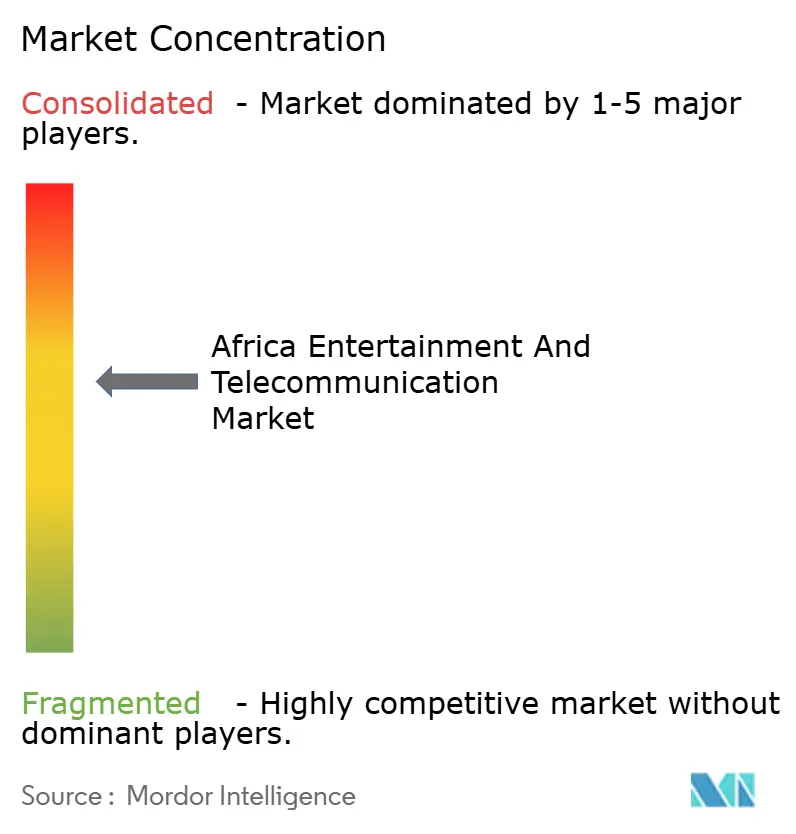
Recent Industry Developments
- March 2025: Telkom South Africa raised USD 371.5 million from a tower sale, redirecting proceeds to core network upgrades.
- March 2025: MTN Group and Airtel Africa finalized network sharing in Nigeria and Uganda to cut deployment costs and lift service quality.
- February 2025: Canal+ restructured its MultiChoice acquisition, creating an independent LicenceCo to meet South African media-ownership rules.
- January 2025: The Nigerian Communications Commission approved a 50% tariff increase for operators, helping offset currency-driven cost inflation.
Africa Entertainment And Telecommunication Market Report Scope
The market is defined by the revenue generated from the sale of entertainment and telecommunication solutions in Africa.
The African entertainment and telecommunication market is segmented by market type (telecommunication services [voice (fixed and mobile), data (fixed and mobile), and others], entertainment [digital music [music download, music streaming], video games, video-on-demand [SvoD, TVoD, video downloads], e-Publishing, advertising [newspaper, magazine]], by country [South Africa, Nigeria, Morocco, Kenya, and rest of Africa]). The market sizes and forecasts are provided regarding value (USD) for all the above segments.
| Telecommunication Services | Voice (Fixed and Mobile) | |
| Data (Fixed and Mobile) | ||
| Other Telco Services (IoT, Messaging) | ||
| Entertainment | Digital Music | Download |
| Streaming | ||
| Video Games | ||
| Video-on-Demand | SVoD | |
| TVoD | ||
| Download-to-Own | ||
| e-Publishing | ||
| Advertising | Newspaper | |
| Magazine | ||
| 2G |
| 3G |
| 4G / LTE |
| 5G |
| Satellite Broadband |
| Subscription |
| Advertising-Funded |
| Micro-transactions / Pay-Per-View |
| Licensing and Wholesale |
| Consumer | |
| Enterprise | SME |
| Large Enterprise |
| South Africa |
| Nigeria |
| Morocco |
| Kenya |
| Egypt |
| Ghana |
| By Market Type | Telecommunication Services | Voice (Fixed and Mobile) | |
| Data (Fixed and Mobile) | |||
| Other Telco Services (IoT, Messaging) | |||
| Entertainment | Digital Music | Download | |
| Streaming | |||
| Video Games | |||
| Video-on-Demand | SVoD | ||
| TVoD | |||
| Download-to-Own | |||
| e-Publishing | |||
| Advertising | Newspaper | ||
| Magazine | |||
| By Connectivity Technology | 2G | ||
| 3G | |||
| 4G / LTE | |||
| 5G | |||
| Satellite Broadband | |||
| By Revenue Stream | Subscription | ||
| Advertising-Funded | |||
| Micro-transactions / Pay-Per-View | |||
| Licensing and Wholesale | |||
| By Subscriber Category | Consumer | ||
| Enterprise | SME | ||
| Large Enterprise | |||
| By Country | South Africa | ||
| Nigeria | |||
| Morocco | |||
| Kenya | |||
| Egypt | |||
| Ghana | |||
Key Questions Answered in the Report
What is the current size of the Africa entertainment and telecommunication market?
The market stood at USD 88.16 billion in 2024 and is projected to reach USD 120.03 billion by 2030.
Which segment holds the largest share of revenue?
Telecommunications services accounted for 76.1% of 2024 revenue, underscoring the sector’s foundational role.
How fast is 5G adoption growing across Africa?
5G connections are forecast to advance at a 32.7% CAGR between 2025 and 2030, making it the fastest-growing connectivity technology.
Why are ad-supported streaming tiers gaining traction?
Advertising-funded models are rising at 7.8% CAGR because they lower price barriers for cost-conscious viewers while opening new revenue for platforms.
Which country shows the highest growth potential?
Nigeria leads with a 6.63% CAGR outlook, supported by its large population, smartphone uptake, and recent tariff adjustments that fund network upgrades.
How are operators coping with currency devaluation?
Measures include tariff revisions, infrastructure sharing to curb capex, and diversification into data centers and fintech to broaden revenue streams.
